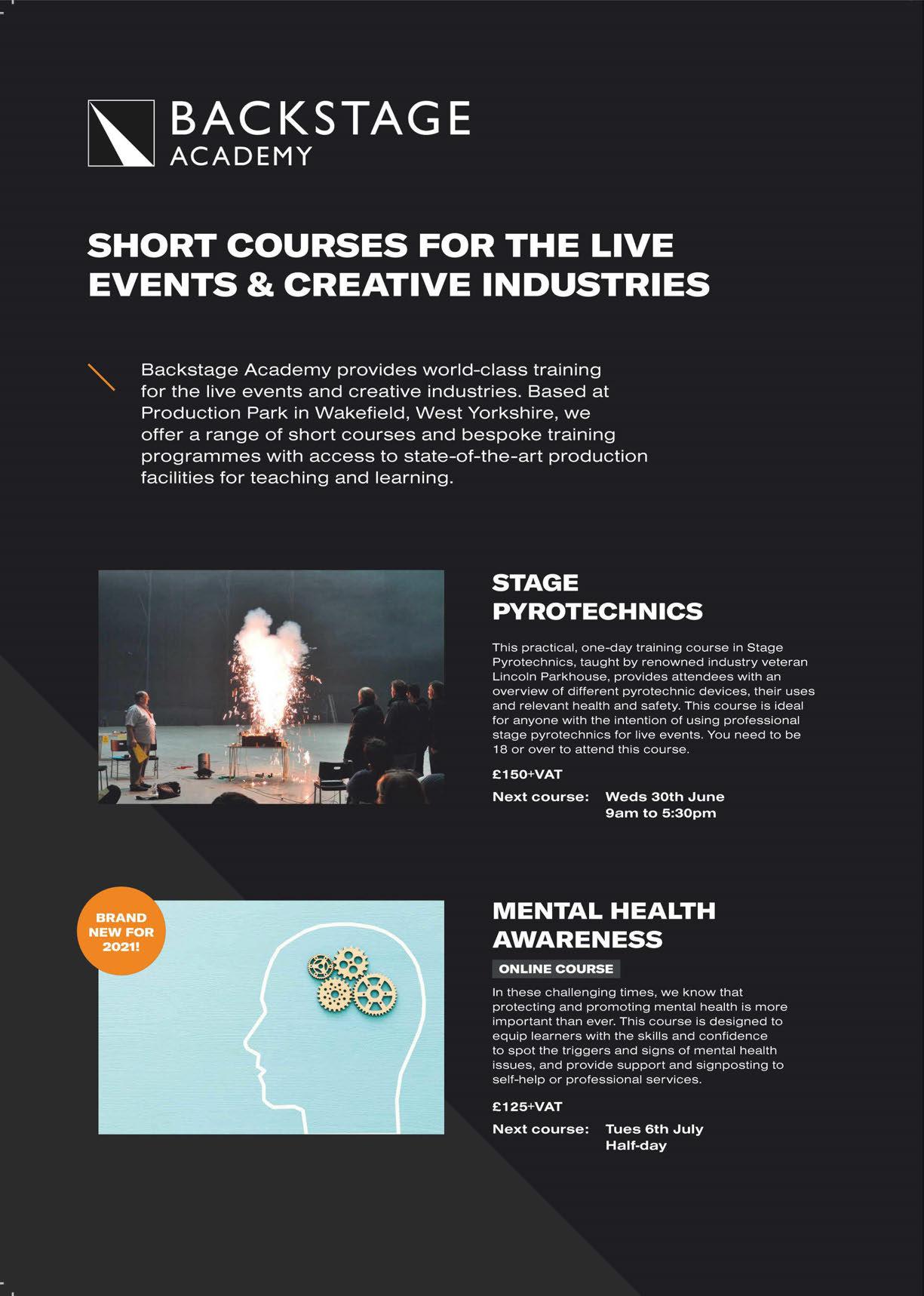
26 minute read
Eurovision Song Contest 2021
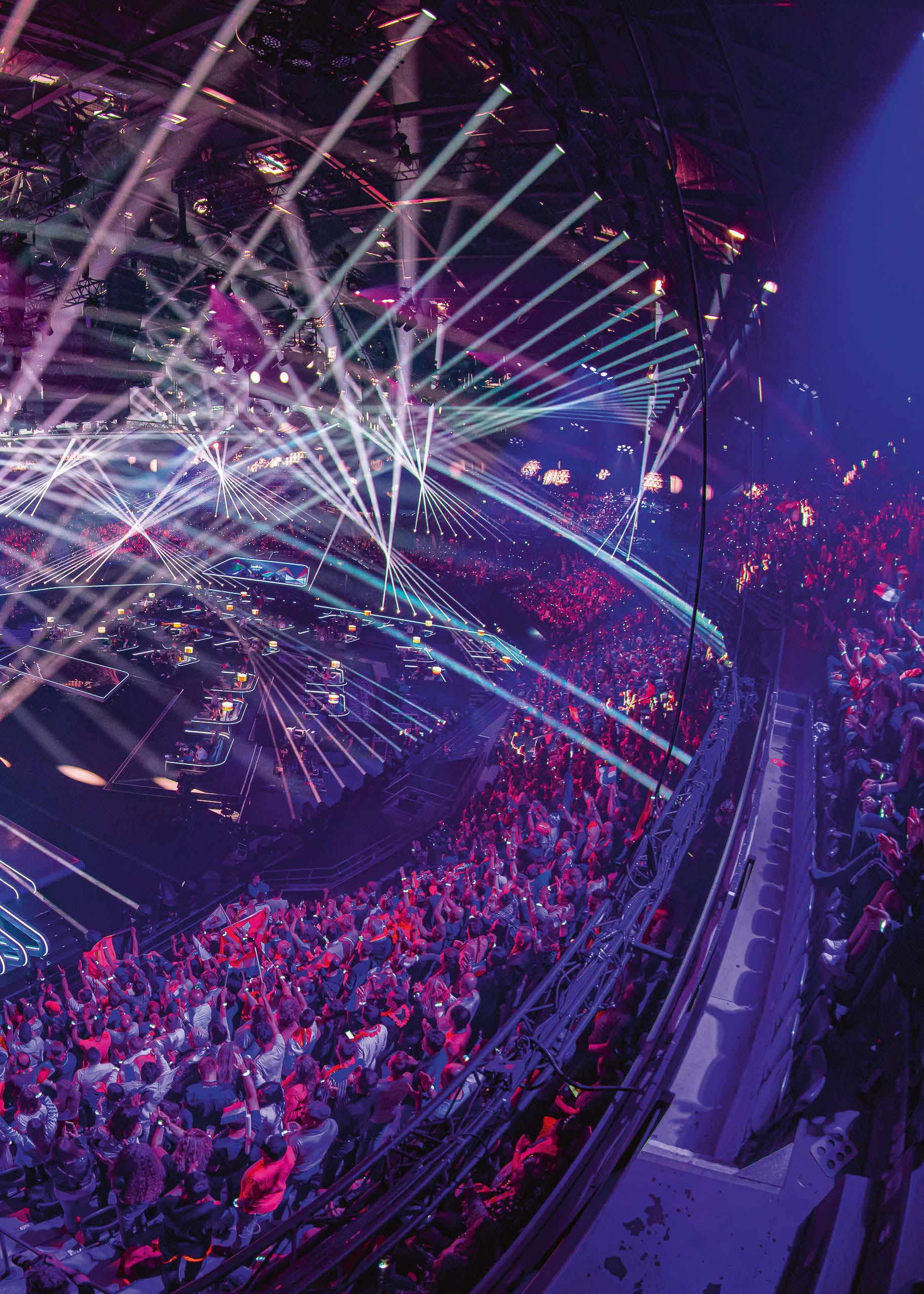
Following a fallow year, Eurovision Song Contest returns with a technologically advanced showcase in front of a 3,500-strong crowd in Rotterdam Ahoy and broadcast live to millions of viewers across the globe.

With its global fanbase having to wait an extra year, the 65th edition of Eurovision Song Contest (ESC) was back, much to the pleasure of those watching at home and the lucky 3,500 fans and delegates able to attend the event in-person. With around 183 million television and online viewers, produced by NPO, NOS and AVROTROS on behalf of EBU, organisers pulled out all the stops to present a landmark showcase of live music and technical ingenuity. Following an interactive backstage tech tour via Zoom, TPi put some questions to the core creatives, suppliers and technicians involved in perhaps the largest production the continent will see this year.
Sightline Productions’ Erwin Rintjema headed up a brand-new technical and production team. “I was asked to join as Head of Production very early on, almost as soon as the Netherlands won the ESC in 2019. At Sightline Productions, we specialise in large live music and TV shows, so I guess I appeared on the radar naturally,” Rintjema said. “I was honoured. ESC is a bucket list show for me, so I gladly jumped on board. In the interest of the production, I decided to detach my commitment to ESC from my company, to ensure complete independent focus.”
As the Head of Production, Rintjema was responsible for the entire ESC technical and logistical operation. From set, stage, lighting and broadcast facilities in the main arena, through to the venue layout, office spaces, delegation dressing rooms, press centre and even working with the show and contest team to create the best possible performances on stage. It was a monumental task, which required the collective expertise of a trusted team of creatives, technicians and suppliers to bring the vision to life. All contracts were won after a competitive European tender procedure.
ESC’s suppliers of choice comprised: Ampco Flashlight for lighting, audio and rigging; Faber Audiovisuals for video; NEP and EMG joint for this project for broadcast and augmented reality; Opertec for special cameras and cranes; The Powershop; Stage Kinetik for automation; Unbranded; Interstage; Pyrofoor; Resal Laser; Riedel Communications; and Broadcast Rental for the remote green room, among others. The collection of suppliers held little back in terms of tech deployment. Ampco Flashlight alone provided around 4,200m of speaker cables, 2,653m of trussing, 1,782 automated lighting fixtures, 506 electric chain hoists, 298 speaker cabinets, 220 tonnes of static load, and more – making this year’s showcase one of the biggest live productions the world has witnessed since the onset of the COVID-19 pandemic.
The core Ampco Flashlight team comprised Account Director, Dennis van der Haagen; Deputy Account Director, Marc van der Wel; Project Director, Marco de Koff, among others. “After an elaborate official European tender process, we were more than pleased to be awarded rigging, lights and audio,” said van der Haagen. “We combined the experience we gained from doing rigging and lights in Portugal in 2018 with our extensive audio track record on the cross roads of broadcast and live music events. This approach was also reflected in the crew we selected.”
ESC was selected as a pilot for COVID-19 safe events in the Netherlands. As well as the 3,500 socially distanced audience, organisers welcomed delegates from each of 39 participating countries. Of course, the event incorporated comprehensive health and safety precautions to ensure the safety of the artists, audience and technical production crew involved.
“We started working on various scenarios very early on and from a production point of view, quickly made the call to go for a production and venue layout in which all possible scenarios would work,” Rintjema explained. “That, combined with a very thorough health and safety protocol, allowed us to keep the virus out.” With 39 separate ‘clients’ – the 39 participating countries, each with their own creative team, designers, performers and budgets – Rintjema and his team had to be on top of their game. “The sheer scale of the show is enormous in every aspect, which meant we had to ensure we got the best team possible on the job,” he commented. “We focussed on providing our artists the best possible tools to create 39 unique performances on stage, and I think, in the end, that showed.”
‘THE BEST OPERATORS AVAILABLE’ Set Designer, Florian Wieder worked closely with the broadcast team, ESC designers and the production team to curate the set, which comprised multiple performance areas with a ‘flat horizon’, inspired by the canals and
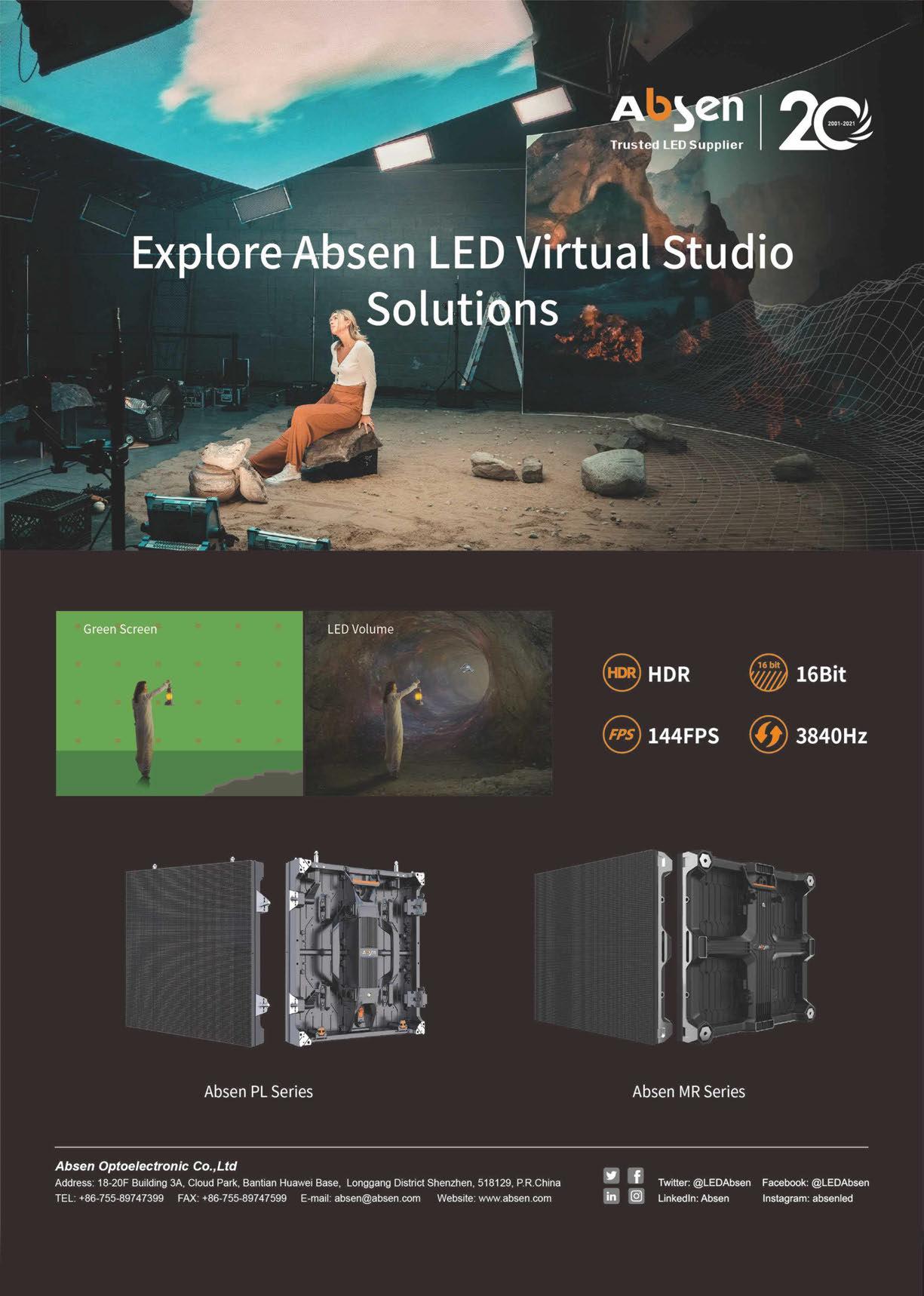

bridges that connect land and water in the Netherlands. “I devised a ‘waves’ style design on the stage in an abstract way which is inspired by Dutch design – highly functional, understated, and featuring linear lighting. It’s all about organisation, like the people of the Netherlands,” he explained.
The design process involved converting Wieder’s initial sketches of the stage into photorealistic renders. Once the design was signed off, the renders were handed over to the art directors to convert into a scaled CAD-3D model and then later to floor and section plans as well as detailed drawings for all set parts and video screens. “We usually bring the audience close to the action. This year, we can’t do that, so we replaced the stage side audience with delegation tables to fill the gaps,” Wieder explained. “I like the simplicity of this design, which is only achievable through teamwork of producers, directors, and creatives – it’s a collective vision.”
Art Director, Cuno von Hahn and Art Director / Project Manager, Per Arne Janssen managed the project, overseeing regular meetings with all the suppliers and production crew and developing design ideas for opening and interval acts. Unbranded Account and Project Manager, Antoine De Haas and Project Manager, Miranda Koopman were brought in to oversee decor. A team of 35 were closely involved in the construction and more than 20 trailers with equipment for decor. Unbranded CCO, Olivier Monod de Froideville, commented: “Unbranded was proud to be able to make an important contribution to this international mega-event and to bring Florian Wieder’s designs to life.”
Henk-Jan van Beek of Light-H-art described how he picked his ESC crew: “I included a broad team of the best operators available – three with theatre backgrounds, two with EDM experience, and many from TV and broadcast. I was only able to achieve my vision with the right crew – specifically Associate LDs, Bas de Vries and Joost Wijgers for stage design, and Martin Beekhuizen, who managed the interests of 39 delegations.”
This year, the visual team were able to harness the openness of the set and motion elements to shape the aesthetic and narrative of each song or scene. Despite containing relatively low fixture numbers, the lighting rig featured more powerful lights that packed a punch – especially when partnered with motion elements, doors, banners, and drop arms. In a show that featured everything from AR elements to complex follow-spot automation, Van Beek was elated by the “distinctive” looks he was able to offer. “We were asked to design a modern look and feel with our own style, which included the integration of the green room,” he reported.
With such an array of tech possibilities, it would have been easy to fall into option paralysis, but as the Head of Lighting explained, the goal was always about making the right choices in what to create as a combination of lighting and all other visual elements.
“Flexibility and cooperation between all creatives – including AR, video content, set design – had to be seamless,” Van Beek recalled. “We always kept the interest of our general design in mind, supporting the delegations to make their act as good as possible.”
ESC Head of Video Content, Falk Rosenthal of Gravity made the AR and LED wall content. “Eurovision is always a demanding production,” he began. “This is my seventh year, but the challenge doesn’t change – creating content for all the various performances is tough. We brought in AR in 2019, but Rotterdam was the next step in pushing things forward. I’m sure this show will influence the next generation of show productions.”
The lighting team had control over the quantity of lighting output of the LED wall and floor. “We made sure we kept the same colour temperature balance between lighting and video, keeping the white and level balances of video, front light and follow spots matching,” reported van Beek.
Conducting this orchestra of light was always going to require a sizeable control setup. Ampco Flashlight supplied 14 MA Lighting grandMA3 light consoles and 32 active grandMA3 processing units (PUs).
Along with an arsenal of lighting fixtures at their disposal, the design team also had another fleet of virtual lights to further the collective creative vision. The virtual lights in augmented reality were controlled by several
Art-Net universes. There was a connection with the disguise media servers to control the intensity of the LED screens and even use the lights around the LED screens as an ‘ambilight’ effect. Rotterdam Ahoy house lights were also connected to the system. Monitoring of the universes and fixtures was achieved by dmXLAN, Network Monitoring via PRTG. All fixtures were addressed via RDM and tested with the FixtureTester App.
Follow spots were situated at various angles to avoid collision with fly cams or other objects. “We had a great liaison between the delegations and our lighting FOH crew,” Van Beek noted. There were 12 RoboSpot stations with 14 cameras, which controlled several BMFL WashBeams, BMFL Followspot LTs and Motion-Cams. These were controlled by MA Lighting grandMA3 light consoles through Art-Net and all connected in a redundant network for the 26 cameras and the DMX-RDM data. The second spot options came in the form of a Follow-Me system.
Follow-Me 3D SIX with three console sets operated multiple lights as follow spots, allowing 64 calibrated fixtures to be operated in any combination at the same time – namely, 58 Ayrton Huracán-Xs and six Robe BMFL WashBeams. PosiStageNet communicated with these positions and Follow-Me kept all follow spots exactly on target accordingly. With three targets available, grandMA3 controlled which fixture(s) should be aimed at which target.
Show lighting came in the shape of 481 Claypaky Xtylos; 161 Ayrton Huracán-Xs, 140 Mini-Panel FXs and 64 Karif-LTs; 396 Robe Spiiders, 220 LEDBeam 150s and 25 Tetra 2 Battens; 100 GLP impression FR-10 Bars and 40 JDC1s; as well as 10 Astera AX-2 Bars. For atmosphere, the team deployed four MDG ATMes, two M3es, four Look Viper NT Fog machines and 10 Martin by Harman AF-1 MK2 fans.
Ayrton Húracan-Xs were used as main key light and Follow-Me follow spot key light (40 units, in drop arms, 24 side and backlight), and Robe BMFL as front key light and front follow spot light. “It was a fantastic experience,” said Van Beek. “My wonderful team did an amazing job. Their experience made this monumental task achievable. We made our own choices in what to create as a combination of lighting and all other visual elements. Flexibility was key to making this the best show possible.” The core lighting crew comprised Head Lighting Designer, Henk-Jan van Beek; Associate Design/Delegations Liaison/Followspots, Martin Beekhuizen; Associate Designer, Bas de Vries; Gaffer Light, Bart van Stiphout; Operator Key Light/Followspots/Assistant LD, Joost Wijgers; Operator/Assistant LD, Micky Dordregter; and Showlight/Audience/Set and Prop Lighting Operators, Robbert Jan Vernooij, Andre Beekmans, Erik Jan Berendsen and Bas Geersema.
The Ampco Flashlight team comprised PM, Ruud Werkhoven; Crew Chiefs, Tijs Winters and Martin Hoop; Lead Systems Tech, Roy Aarninkhof; and Lead Systems Tech for Remote Follow Spots, Dennis Berkhout.
SFX was controlled by an MA Lighting grandMA3 light console, while pyro was controlled by a Pyrodigital FC-A field controller. By providing five separated Pyrodigital network drivers, the FC-A field controller provided redundancy and enhanced firing power. In show mode, every cue was preprogrammed and triggered by timecode.
Pyrofoor created a complete digital 3D environment for both SFX and pyro, using Finale 3D for the pyro and Syncronorm Depence² for the special effects. For the first time in the history of ESC, all suppliers were able to visualise the effects in advance. “The use of the visualisation software is a powerful tool in the communication with production and delegations,” said Pyrofoor Project Controller, Lucas Gerritzen. “It gives us the ability to share the effects and timing in advance to all parties.”
Pyrofoor Show Manager, Jessy Maas, added: “We want to be sure the show is predictable and safe every time. We use strict protocols, which are implemented in advance in our risk assessments. We use digital safety channels as well as physical emergency stops. We train the crew to watch and give clearance to the operators. No clearance, no go!”
Resal Laser provided four LaserAnimation Phaenon X30000 30W RGB lasers with on-board DSP control systems and remote safety access, including two DSP controllers at both sides of the arena. The lasers were pre-programmed to timecode and in Capture, which was also used for pre-programming cameras, lights, video and motion. The Resal Laser team comprised PM, Michel Povee; Senior Programmer / Operator, Remco Borsje; and back-up crew members, Koen Janssen and Robert Dame.

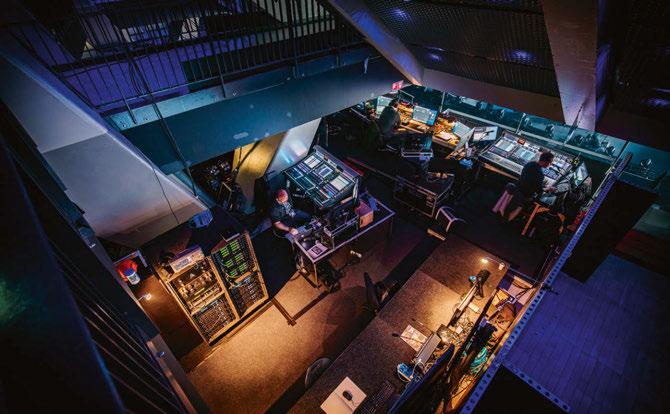
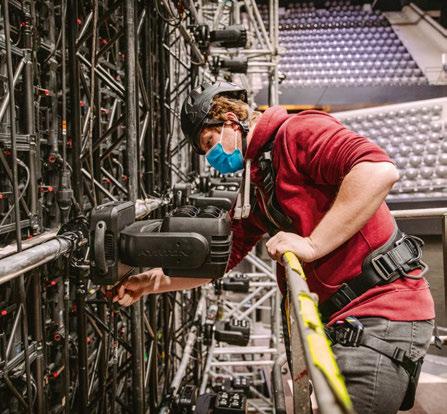


Audio FOH; Mounting Ayrton Mini Panels with mirrors on the back of the revolving doors; Lead Systems Tech for Remote Follow Spots, Dennis Berkhout operates a Follow-Me system; Audio Engineer, Tom Gelissen.
‘SOUND QUALITY AND SPECTRUM EFFICIENCY’ Sounding out the show, Jeroen ten Brinke assumed the role of Audio Designer. “I was given free rein on the design,” he began. “I had seen the setup in Lisbon where Daniel Bekerman was sound designer and the first thing I did was call him. We created our design and then listened to him to make sure we were doing the right thing.”
A main and backup loop comprised two DiGiCo Quantum 7 consoles, two SD racks, and a DiGiCo SD9 console. Driven by a redundant system via Lake LM44, Outline Newton and switches, and an L-Acoustics PA system. “I wanted to have the consoles as close together as possible, with short cables that were easy to troubleshoot,” Ten Brinke explained. “The monitor desk was behind glass, so the monitor engineer didn’t have any problems with the spill from the PA. The consoles were situated approximately 1.5m apart, so the team could interact. This made things easier, more fun and meant we could keep spirits up for the month we were on site.”
Another reason for the position of the consoles was the required speed of changeovers. “You’re always in the way at the side of the stage, or in the camera view. We were on the top of the first rake and all together – no long cable runs, only to the PA and a few analogue inputs for backup mics,” Ten Brinke said. “The rest was all local.”
A redundant loop was set up for monitors and FOH systems, based on DiGiCo and fibre networks with inputs from Shure wireless systems, along with playbacks by three Mac Minis, a trio of RME MadifacexT and a Directout Madi switcher, both through a DiGiCo Orangebox. Also present on the rig were two Yamaha CL1s, two Rio 1608-2s and two Yamaha Rio 3224-2s. Timecode ran through the desk, so the Quantum 7’s double power supply and engine made the engineers happy. “If the timecode stops, everything stops, as all departments are running through our timecode,” Ten Brinke stated. “That’s the most important function on monitors. These machines are so safe and reliable. I’ve done a lot of big shows with them, so I trust them. The most important thing is safety. It just can’t stop working.”
Also at the audio team’s disposal was a dedicated soundcheck room with the same setup as in the arena, with IEMs on different frequencies, transmitter packs and handhelds. Looking skyward, the main stage L-Acoustics PA system comprised 76 K1s, 36 KARAs, four SB18s, six X12s and 18 KS28s, amplified by 84 LA12Xs. Monitoring was handled by 10 L-Acoustics KARAs, eight Synco CW152 wedges and four CW121s. The under balcony featured 10 L-Acoustics 5XTs, driven by two Outline Newton processors and 10 Lake LM44s.
The greenroom included 56 Synco TRC81s, 40 L-Acoustics K2s and 16 KARAs. The main venue wireless system specifications included 20 Shure Axient Digital Quad receivers, 24 Shure ADx2FDs, 14 Shure ADx2s, 24 Shure ADx1 beltpacks, 100 DPA 4088s, 36 DPA D-facto heads, and 120 DPA Korfs.
“With Shure’s Axient Digital, we found the perfect system to monitor and coordinate the complex audio setup that Eurovision required, in which sound quality and spectrum efficiency are key,” said Ampco Flashlight Wireless Coordination Technician, Aart Heus. “Shure’s Wireless Workbench was the most qualified software for it. The hardware not only provides control and stability, but it is also trustable and reliable.”
IEMs came in the shape of 11 Shure PSM1000 transmitters, 70 P10R IEM receivers and 240 SE425s. Strict COVID-19 protocols were followed, including no direct contact between monitor engineers and talent, with one IEM and one mic capsule specified per performer and handheld mics cleaned every three minutes.
Ampco Flashlight Project Manager, Remco Verhoek and his team had to make a proof of concept before putting custom racks together. “I made sure that all the gear specified within the pitch was supplied, making it work as a whole, putting the team together and looking after the functioning of the equipment and of the people,” he recalled.
While Ten Brinke specified the audio equipment, given the complexity of the system, stakes were high. “With all the experience we have with DiGiCo, it was a good setup and straightforward for us,” Verhoek said. “The infrastructure performed as we hoped without a single issue. There was a backup setup, but we didn’t have to make use of it.”
The core audio team comprised Audio Designer, Jeroen ten Brinke; Ampco Flashlight Project Manager, Remco Verhoek; Monitor Engineers, Ron Peeters and Peter Velthuijzen; FOH Engineers, Tom Gelissen and Ronald Koster; Playback Engineers, Willem de Bruin and Robert Jansen; Lead IEM and RF Tech, Aart Heus and RF Engineer, Johalee Glastra; and PA System Technician, Jurriën Hildebrand.
VISION OF THE FUTURE While bombastic performances often steal the headlines at ESC, away from the on-stage choreography, there is an equally impressive orchestration being held in the rafters – electric motors, hydraulics and pneumatics are designed to seamlessly move kit around in a symphonic fashion.
As curators of this year’s proverbial ballet of automated technology, supplied by Stage Kinetic, where production rigger Michiel Peters and house rigging company Frontline Rigging oversaw 285 tonnes of dynamic load, at 220 ton static, with the deployment and supervision of Lodestar chain hoists and BroadWeigh load cells. Audio alone featured 50 hoists, while lighting boasted 208 hoists situated throughout the venue from above the stage to up high in the bleachers in addition to several trusses containing moving objects, monitored by load cells.
The Opertec camera crew were provided 22 hoists with three rigging structures for the rail camera, fly camera and fixed flown camera positions. Decor and the set build saw the deployment of 13 hoists – 12 for the load-in on and off stage and for the build, with one separate hoist used to lift the bridge between the A-Stage and the B-Stage, allowing larger pieces of tech to be moved from left to right if required. The pyro department was provided with 11 trusses for effects.
Stage Kinetics also created a support grid for automation and video, which featured a combination of 30, 2,000kg and 28, 1,000kg electric chain hoists and 37 manual lever hoists.
For lighting, video and audio, the team created decks so each department could easily build their power and data racks on the ground before flying the kit, keeping the catwalks clear of equipment while being accessible. Part of lighting cabling was run through dedicated cabling trusses with dedicated hoists. Sixteen chain hoists were then tasked with flying LED screens. A further five trusses were dedicated to augmented reality, hosting 100 reference points in the grid for the camera team to bring AR to life. For automation, 40 drop-arms were used as a telescopic headlight holder that could be moved vertically from the ceiling.
Involved in eight previous iterations of ESC, Head of Video, Hans Cromheecke was the glue between the technical departments operating screens and content. “Eurovision has always been a job where the limits of AV are reached and broken with new technologies,” he commented. “It is a wild circus with over 180 million people watching all over the world!”
Faber Audiovisuals supplied all LED, media servers, video equipment and crew. Project Managers, Ben Augenbrou and Steve Ackein oversaw the deployment of 887 sq m LED video screens – specifically 6m of ROE Visual Strip 9.3mm for the Maltese band; 110 sq m of Vanish 8 for the runaway screen; 3.6 sq m of CB5 for AfroJack’s DJ booth; 127.1 sq m of BM4 for Stage A and 27.1 sq m for Stage B; 508 sq m of BQ4 4.6mm for the backdrop and 48 sq m for A Stage truss covers; 7.5 sq m of DM2.6; and 59 sq m of Unilumin Utile for audience screens, as well as disguise media servers.
“Everybody was impressed by the very high level that was brought by all parties under direction of the people from Sightline Productions,” Augenbrou said. “This event has raised the bar in terms of organisation and technical solutions.”
For projection, Faber Audiovisuals supplied two Barco 30K UDX-4K32s, three Panasonic 10K PT-RCQ10s and a 20K PT-RZ21K. The team also provided TV displays across site, including a Philips BDL9870EU AutoCue, as well as almost 100 LG, Sony and Samsung LCD TVs. The media server and control setup featured a pair of Barco E2 Tri-Combo switchers, an EC-50 event controller, eight disguise gx 2c and four vx4 media servers with integrated Notch. The visual content was networked by a Synology Nass Cloud server and three Netgear mainframe switches.
It was clear for the team involved that ESC 2021 was not going to be any other incarnation of the event to date. “We all knew that we had to make this work in a very difficult and unprecedented situation,” Ackein added. “The sheer scale of the event in terms of the amount of equipment, crew
BECAUSE EUROPE IS OUR HOME WE SUPPORT EVERY ARTIST NOT IN POINTS, JUST RAW KILOWATTS
AS A PROMISE WHEREVER THE WINNER COMES FROM, WE’LL GO THERE TOO
and duration of the event possessed a challenge that was well handled during the preparation phase.”
A ‘turnable’ LED wall was divided into four sections – featuring two side wings and two rotating walls in the middle. The rotating walls were 9m wide and 12m high. The four elements closed without gaps using a magnetic locking system. Together, four motors were able to turn the wall by 180° in around 16 seconds to make the back of the LED wall visible, which was equipped with a matrix of 70 moving-head lights. In front of and behind each rotating LED wall, around 60 sq m of stage floor was also rotated. The side LED wings sat with their brackets on a steel chassis, each of the 18 steel trolleys could accommodate four rows of LED modules.
The high level of operational reliability demanded by the EBU required the team to provide a fully redundant system. “We are proud of the solutions we provided, the way we put them into practice and delivered flawlessly,” Augenbrou continued. “This has been a unique chance for us to show to the world what we are capable of. We have gained a lot of extra experience and knowledge, which we will be able to use in the future.”
After a year of work away from the sector, Michiel Peters was pleased to assume the role of ESC Head of Rigging. “We decided to hang most of the motion hoists without main grids and lost a couple of tonnes,” he began. The load-in schedule was challenging, Frontline Rigging and Ampco Flashlight had to pull 514 chain hoists and 60 motion hoists, inverted 124kg body-up, in 30 hours. Despite the tough task, it was a privilege and an honour to work for the ESC 2021, especially amid this pandemic. It was a big project, challenging at times, but I would do it again in a heartbeat.”
The Stage Kinetic crew comprised CEO/PM, Jens Buller; Site Manager, Sascha Schaper; Operators, Fabian Röttger, Andreas Homeyer, Ralf Tiemann and Manuel Dehn; and Construction Department, Kai Adelt and Thorsten Lobert. Ampco Flashlight supplied all of the rigging infrastructure, overseen by Head Riggers Roald Gluvers and Joey Dunnewijk and Lighting/ Rigging PM, Ruud Werkhoven. The rest of the Ampco Flashlight rigging team comprised Crew Chiefs, Dirk Sommer and Christiaan Schutte. tender, both media parties were commissioned by the NOS to take care of the registration, including all technical facilities, crew and equipment, of the three live shows at Rotterdam Ahoy. NEP supplied the AR-platform, while Gravity supplied the AR and LED screen content.
“We are enormously proud that two Dutch companies got the opportunity to capture this huge music event,” commented NEP Managing Director, Ralf van Vegten. “The ESC is an event that connects people and something the public really looks forward to. That’s why the expectations and quality standards are higher than ever before.”
United CEO, René Delwel added: “It’s nice to see how the two companies are working together as one team for this enormous event. We consider the 65th edition of the Eurovision Song Contest to be unique and of great national importance. Our people are very aware of that and work hard to deliver the best solutions and results.”
To ensure sound quality and reliability, NEP equipped its UHD1 and UHD2 twin OB trucks with 64-fader Lawo mc²56 consoles, Nova routing cores and Lawo’s VSM broadcast control system for control of the broadcast chain. Two OB trucks were set up in a main/backup configuration for protection switching. Two further 48-fader mc²56s, along with monitoring equipment and outboard gear from Lawo Rental, were stationed in a separate Music Room where Music Producer, Tijmen Zinkhaan mixed the delegation and interval acts.
While all broadcast audio connections were streamed via RAVENNA/ AES67, the audio signals for the PA at the Ahoy venue were provided by Dante cards inside the Nova routing cores. “There was never any doubt that Lawo consoles were perfect for this prestigious assignment,” stated ESC Head of Sound, Thijs Peters. “They sound great, their routing capabilities are infinite, our setup integrates seamlessly and can be conveniently and intuitively controlled via Lawo’s VSM broadcast control system.”
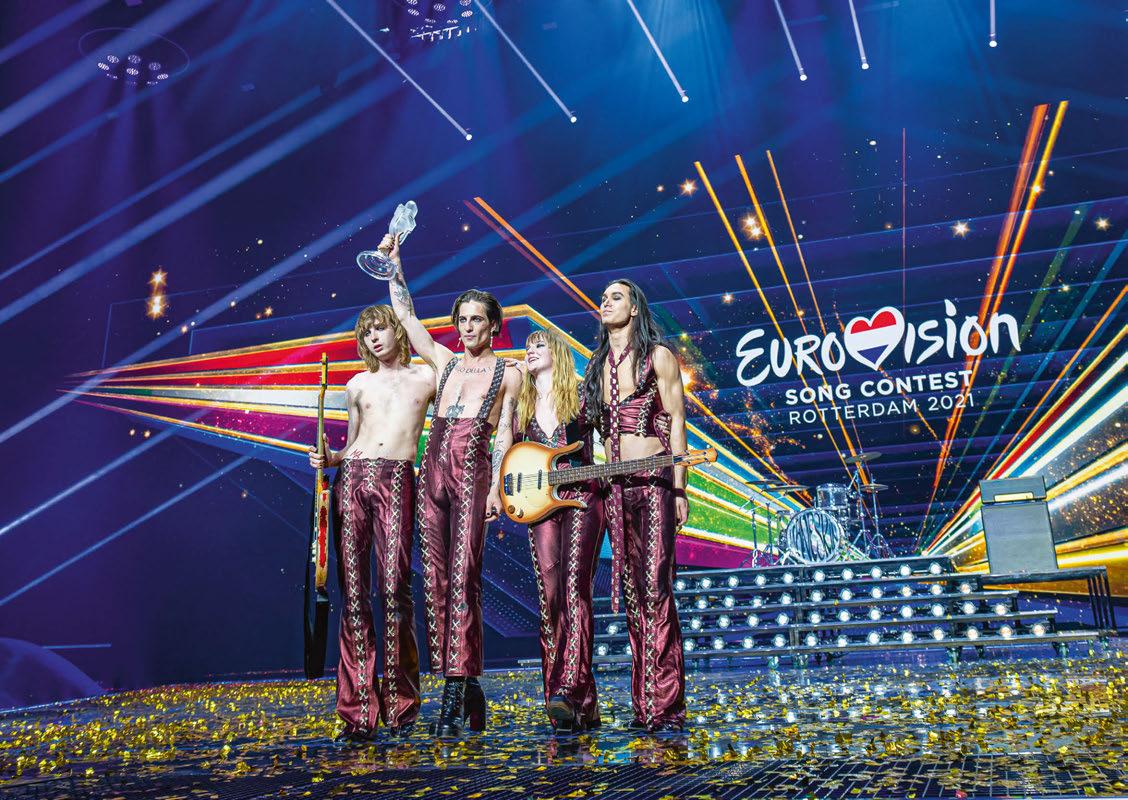
COMMUNICATION WAS KEY With so many moving elements to contend with, communication was key. Riedel was responsible for the delivery of communications, signal distribution, fibre backbone, accreditation front end, commentary and access control solutions including associated professional services. “Since we have the pleasure of being a long-term partner of EBU for our
ESC services, the process of each year’s edition is mainly about liaising with the new host broadcaster in order to align the contractual scope with their actual concept, way of working and delivery as well as related requirements,” Riedel’s Thurid Wagenknecht explained. This year marked several ESC debuts for Riedel products such as Artist-1024, MediorNet MuoN and FusioN as well as dedicated COVID-19 feature for this year’s accreditation and access control.
Riedel also integrated in the testing environment within the on-venue accreditation process, this year’s specialised access control feature was designed to minimise the risk of COVID-19 transmission. The RFID-based solution included automatic deactivation of accreditations after 48 hours, with re-activation upon submission of a negative COVID-19 test result.
“ESC 2021 definitely set new benchmarks in delivering an extraordinary show under ‘pandemic circumstances’. Every project comes with its own set of unique challenges,” Wagenknecht added. “Being in the business for over 30 years makes us consider COVID-19 as just another challenge. While we take all these challenges seriously, we meet them as we always have: with the highest level of flexibility, adaptability and professionalism.”
‘WHAT A RIDE IT HAS BEEN’ The Powershop was selected as the technical supplier for show power. The entire show ran on power supplied by the company’s modern and efficient generators. The power had to be supplied with the highest possible availability with everything redundant in the power design and a generator compound, affectionately referred to as the ‘generator farm’ by the crew, was set up outside Rotterdam Ahoy.
The farm boasted six twin 400kVA 20ft generator containers with a total capacity 3.8 MW, an 8,000 amp switch container, 20, 400 Amp power distros, over 100 power distros (125, 63,32 amp), 3,500m of 120mm2 powerlock cable sets with a total cable length of 17.5km and 5,000m of power cable. The entire setup was monitored with Powershop’s Calculus monitoring platform and GridVis software.
As with any complex production, the success of the Eurovision Song Contest was in the detailed planning and preparation of every element, while managing a plethora of production stakeholders including performers, producers, designers, suppliers and crew. While TPi experienced this year’s celebration of live music and technical proficiency on TV, what transcended through the screen was the creative foundation for the choices made in preparation of and during the show in Rotterdam.
Early on, organisers coined the slogan ‘open up’ or rather, ‘open up to each other’, when marketing ESC. Having been given the green light to welcome acts and delegations from 39 countries in Europe, as well as a socially-distanced audience of 3,500 people, the ESC doors were well and truly open, albeit in the ‘new normal’ sense, of open.
Following the devastating effects of COVID-19 – not only on last year’s proceedings but on the entire sector – we can find solace in the modest closing sentiments of ESC Head of Production, Erwin Rintjema. “What a ride it has been!” he exclaimed. “I feel so fortunate to be able to be part of the Eurovision Song Contest 2021. It is a great honour and a career highlight at any time, but to be able to put on this spectacle in 2021 is amazing.
He added: “It has been a rollercoaster and a lot of hard work, with a lot of uncertainty and frustration at times. However, the reward has been better than I could have ever imagined. I believe that we have put on a great show, in a year where live entertainment is few and far between. I see this project as a sign of the hope and resilience of the sector and a showcase of the Dutch live events industry. Although we have only just passed the finish line, I already miss being a part of ESC, so I guess that says it all!” TPi Photos: Nathan Reinds and Ralph Larmann www.eurovision.tv www.stage-kinetik.de www.ampco-flashlight.com www.sightline.nl www.euromediagroup.com www.ayrton.eu www.light-h-art.nl www.thepowershop.eu www.faber-av.com www.wiederdesign.com www.nepgroup.com www.riedel.net www.adigroup.net www.claypaky.it www.follow-me.nu www.robe.cz www.shure.com www.digico.biz
Black Quartz Vanish and Black Marble supplied by Faber Audiovisuals
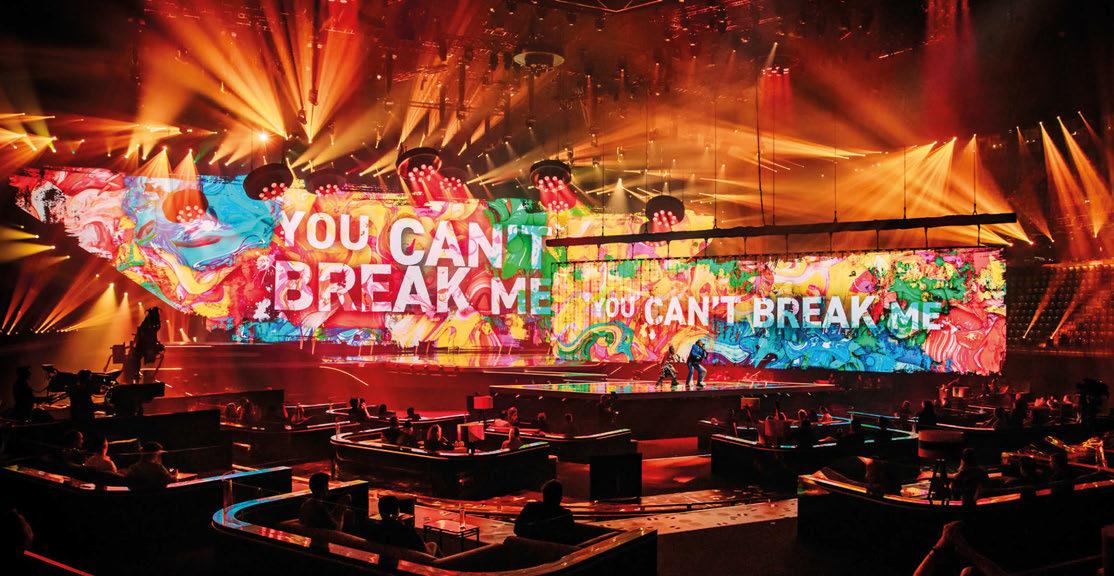
Create the maximum Experience All events have one common factor, your equipment must be reliable at all times. There’s no stopping the show, whatever happens. That’s why the LED screens from ROE Visual are not only of the best quality they are also very reliable, quick to build and easy to service. Whether an out- or indoor event ROE Visual LED products provide the solution to maximize the visual experience for your audience. www.roevisual.com
